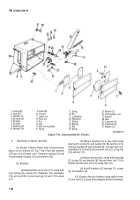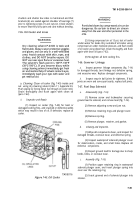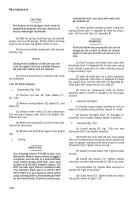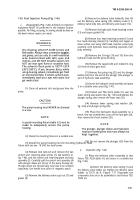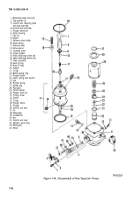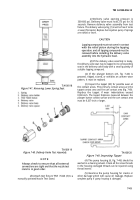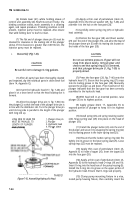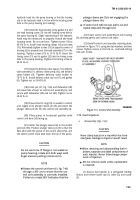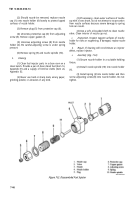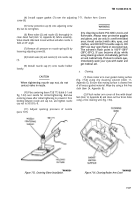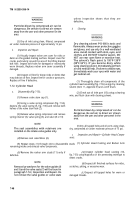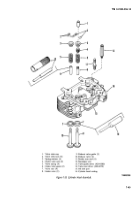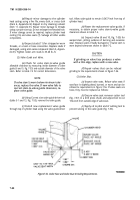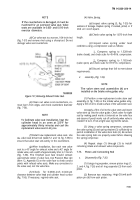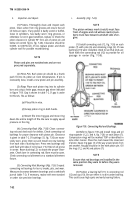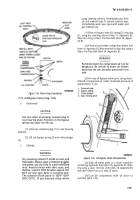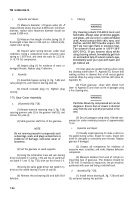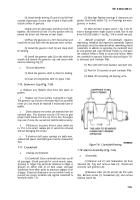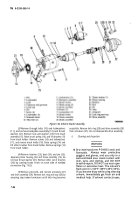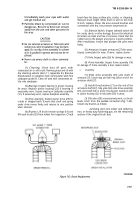TM-9-2330-356-14
SEMITRAILER, TANK: 5000 GALLON, BULK HAUL, SELF LOAD/UNLOAD M967 AND M967A1; SEMITRAILER, TANK: 5000 GALLON, FUEL DISPENSING, AUTOMOTIVE M969 AND M969A1; SEMITRAILER, TANK: 5000 GALLON, FUEL DISPENSING, UNDER/OVERWING AIRCRAFT M970 AND M970A1
TECHNICAL MANUAL; OPERATOR’S, UNIT, DIRECT SUPPORT, AND GENERAL SUPPORT MAINTENANCE MANUAL
OCTOBER 1990
TM-9-2330-356-14 - Page 404 of 528
TM 9-2330-356-14
WARNING
Particles blown by compressed air can be
dangerous. Be certain to direct air stream
away from the user and other personnel In the
area.
(3) Dry oil inlet using clean, filtered, compressed
air under moderate pressure of approximately 15 psi.
b.
Inspection and Repair.
(1) Visually inspect rocker arm cover for nicks or
dents on the gasket mating surface. Inspect cover for
cracks, particularly around the area of the lifting bracket
bolt hole. Inspect bolt holes for damaged or excessively
worn threads, Replace rocker arm cover assembly if
damaged.
(2) Inspect oil line for deep nicks or dents that
may obstruct oil flow. Inspect line for cracks or punctures.
Replace oil line if defective.
7-72. Cylinder Head
unless inspection shows that they are
defective,
b.
Cleaning.
WARNING
Dry cleaning solvent P-D-680 is toxic and
flammable. Always wear protective goggles
and gloves, and use only In a well-ventilated
area. Avoid contact with skin, eyes, and
clothes, and DO NOT breathe vapors. DO
NOT use near open flame or excessive heat.
The solvent’s flash point Is 100°F-138°F
(38°C-59°C). If you become dizzy while
using cleaning solvent, Immediately get fresh
air and medical help. If solvent contacts eyes,
Immediately wash your eyes with water and
get medical aid.
(1) Thoroughly clean all components of the
cylinder head assembly (fig. 7-55) using dry cleaning
solvent (item 11, Appendix E) and a stiff brush.
a.
Disassembly (Fig.
7-55).
(2) Check out oil inlet port (15) using a cleaning
(1) Remove valve stem cap (1).
wire, and flush clean with cleaning solvent.
(2) Using a valve spring compressor (fig. 7-55),
depress the valve spring (5, fig. 7-55) and remove both
halves of the valve stem lock (2).
(3) Release valve spring compressor and remove
spring retainer (3), valve spring (5), and valve (8 or 10)
WARNING
Particles blown by compressed air can be
dangerous. Be certain to direct air stream
away from the user and other personnel in the
area.
NOTE
(3) Dry all tapped holes and oil ports using clean,
The seal assemblies with retainers are
dry, compressed air under moderate pressure of 15 psi.
installed on the intake valve guides only.
c.
Inspection and Repair—Cylinder Head Compo-
(4)
Remove seal assemblies (4).
nents.
(5) Repeat steps (1) through (4) to disassemble studs
(1) Cylinder Head Casting and Rocker Arm
remaining intake and exhaust valve components.
(6)
Remove the rocker arm studs (11) only if
(a)
Inspect cylinder head casting (16,
defective.
fig. 7-55) using Magnaflux or die penetrating technique to
detect cracks.
NOTE
(b)
Inspect all finished surfaces for nicks,
Removal procedures for the valve guides (6
scratches, pitting, or excessive wear.
and 9) and the valve seats (7) will be found in
paragraph 7-72c, Inspection and Repair. Do
(c)
Inspect all tapped holes for worn or
not remove the valve guides or valve seats
damaged threads.
7-48
Back to Top

